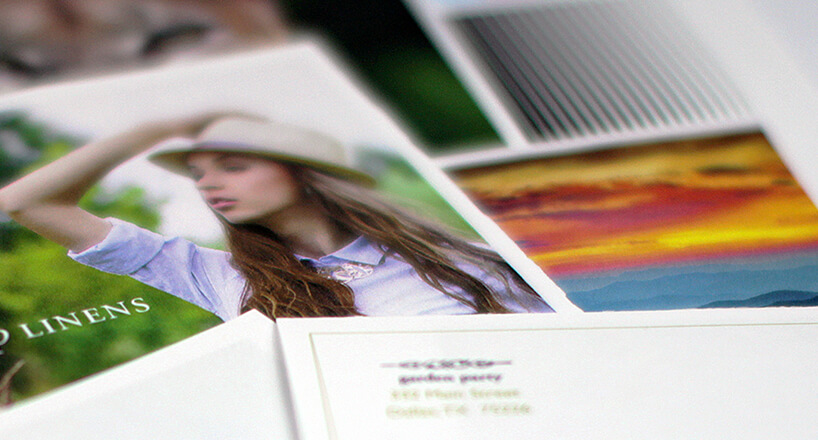What should you keep in mind when designing a project for inkjet printing? Take a look at three tips that can improve results on your next project.
High-speed digital inkjet printing technology opens new doors for designers – from building more personal connections with audiences to printing unique projects more cost-effectively. However, inkjet printing technology is not the same as offset printing or toner-based digital printing and requires some different design approaches.
If you’re new to using inkjet printing technology, follow these best practices to ensure your finished project looks as amazing as you envision it.
Three Steps to Better Inkjet Printing
-
Keep an Open Mind — The guidelines for designing and printing an inkjet project are not the same as those recommended for offset printing, and the learning curve can be steeper than you might expect. The ink formulation is different, the machines might be unfamiliar, and you may need to use paper that has been treated to accept inkjet inks. Approach your first inkjet project with an open mind and a willingness to adjust your expectations.
A great resource to consider is “The Designer’s Guide to Inkjet” by Elizabeth Gooding and Mary Schilling, providing valuable insight to understanding the potential of inkjet printing technology.
-
Shop Around — Think about the intended purpose of your printed piece, and evaluate what’s most important. Is crisp detail essential? Is color matching a must? How long will the piece be used? Is personalization and variable imaging a top priority? Discuss your goals with your printer to determine whether inkjet printing technology is a good fit for your project. You can also check samples of similar jobs printed on inkjet machines to determine whether the print quality is right for your project. Also consider ink type. “The Designer’s Guide to Inkjet” explains that there are two types of inkjet inks: dye-based and pigment-based. Results for each type of ink can vary depending on the machine and type of paper used. In general, dye-based ink is more scratch-resistant because it sinks into the paper. Pigment-based ink tends to sit on top of the paper and can appear more vibrant. Pigment-based ink can also be more colorfast than dye-based ink, providing a longer shelf life.
-
Talk to Your Printer — Once you’ve chosen the right print provider, schedule a call or visit the facility to discuss project specs as early as possible. Share your design and communicate your color-matching requirements. As with any type of printing, your results with inkjet printing technology will improve if everyone is on the same page from the beginning.
Other Design Considerations for Inkjet Printing
Before you get too far down the design path, consider other factors that can impact project results. Discuss these issues with your printer, and take them into account when creating a design for inkjet printing technology.
Paper Options
A wide variety of inkjet papers are available today. Ask your printer for suggestions based on your project goals, design, budget and timeline. Domtar’s collection of inkjet papers offers several readily available options in a variety of weights, calipers and finishes from the brands you trust, including LynxJET®, LynxJET® Premium Card, LynxJET® Dye and HuskyJET®.Whatever your project, priority or budget, Domtar has created an intentional offering of inkjet brands to meet the needs of the transactional, direct mail and commercial printing markets.
Depending on the project, you also may need to consider post-processing performance. Is the paper engineered to withstand the rigors of post-processing applications, such as folding and insertion? Ask your printer to recommend a paper that will not only print well but also perform well in any other required applications.
Linearization
Inkjet performance can vary widely depending on the particular machine, paper and ink. Ask your printer about linearization, a process that optimizes the paper and machine combination to identify the best settings for your project. Without this process, your piece will be printed at the same settings as the last job on the press, which may have had different specifications. Linearization helps deliver the best possible results for your project.
Color Gamut
Inkjet printing technology continues to improve, but its color gamut remains narrower than offset and toner machines. If your design includes colors outside the reach of the press, results might not meet your expectations. To improve quality, share your design with your printer and provide specific direction. For example, you may want to specify how skin tones look or which colors must be exact.
Color Matching
Some inkjet machines can print Pantone colors, which can help finished pieces adhere to brand standards. However, the results on one paper may not be an exact match to the same color printed on a different paper or a different type of press. Your printer can help you choose the right paper and printing specifications to get the best color match possible.
Font Considerations
“The Designer’s Guide to Inkjet” notes that inkjet printing can be prone to higher dot gain than offset printing, which can close in letterforms and make copy more difficult to read. Therefore, reversed type may not be ideal for the body copy of a project designed for inkjet printing technology. Ask your printer for additional font guidance based on paper type, machine type and ink type.
Dimensions
Inkjet machines may not use the same paper sizes as other printing methods, especially if you’re using a sheet-fed press. As early as possible, discuss the dimensions of your project with your printer so you can avoid having to resize it later.
For more information on inkjet printing technology and best practices for production and design, read “The Designer’s Guide to Inkjet,” written by Elizabeth Gooding and Mary Schilling and distributed by Canon Solutions America. For regular technology updates, follow the top inkjet press manufacturers on Twitter (@Canon_Solutions, @RicohTweets, @HPGraphicArts, @XeroxProduction, @KodakPrint and @PitneyBowes).

